Let's say you, as the owner of a transport and logistics company, have a fleet with several dozen vehicles in it. Of course, you should understand the condition and location of each of them. Where is a certain vehicle? What is its status? Isn't it time to renew the car registration? When is the next vehicle inspection required? Yeah, there is a lot of work to be done with the fleet.
Fortunately, most of these problems can be solved with innovative digital solutions. In the end, it’s much easier to have access to all real-time vehicle data through an application or website. Thus, you always have the information you need at your fingertips.
Perhaps this is the reason for such rapid growth in the fleet management software development market. Moreover, it is expected to have reached nearly $ 35 billion by 2025.
The conclusion from the above is obvious: it's high time to strengthen your business with IT technologies and develop a fleet management system too. What do you think?
The topic is interesting and worthwhile, and we're happy to discuss it with you at greater length.
What is Fleet Management Software (FMS)?
The fleet management market is actively and willingly introducing the latest digital products. It can be compared to the banking, financial, and e-commerce industries in this respect.
Participants in the process of logistics and cargo transportation
-
The owner of the cargo who needs to transport it from one point to another;
-
Carrier company with vehicles (vehicle fleet);
-
Sometimes, 3PL (third-party logistics) companies, which provide logistics, delivery, and storage services. They act as intermediaries in matters of delivery of goods and help organize cargo storage and transportation (with tracking the movement of vehicles);
-
Truck drivers who transport goods;
-
Representatives of terminals in ports or airports (in the case of international transport of goods).
All participants in the process of transporting goods are important, but in our article, we focus on companies with their own fleet and discuss the software they need.
What are fleet management apps?
FMS allows businesses to simplify their fleet management with user-friendly digital solutions. What’s more, companies are able to make effective fleet decisions and save resources.
Traditionally, the FMS system consists of the following elements:
-
fleet management software, which can be either cloud-based, accessible from any device, or installed on-premise;
-
additional gadgets and trackers, installed in the vehicle. They collect information about the car's movement and condition and transfer it to the main system. As a result, the dispatcher's screen (or smartphone screen) displays important real-time vehicle data. And the fleet owner can control his vehicles and see the quality of work of each driver.
Sounds complicated, doesn't it? Not surprising since it's about telematics, which is never simple.
But what is fleet management software in relation to telematics features? Let's discuss it properly.
Telematics functionality
Telematics inherently implies remote control of various kinds of objects and gadgets. The areas of telematics use are extremely wide, including medicine, education, and, of course, transport logistics.
And since we're interested in logistics, we'd like to explain the basic telematics principle applied to fleet management, at least, in a nutshell. Long story short, no matter how far the driver rides, the company hiring him receives maximum information about his location whenever needed.
Telematics vs. GPS tracking
Telematics and GPS vehicle tracking for a fleet management app... is there a difference between these concepts, and if so, what is it?
Telematics features are more complex than simple GPS monitoring. To be specific, in addition to the chance to see the vehicle position in real-time, you constantly get data on fuel consumption, digital tachograph indicators, and so on. And you can share the information with the drivers too.
Why do you need your fleet tracking app?
And yet, how to determine if you need to build fleet management software (from scratch or using ready-made solutions, whichever suits you best)?
The game is worth the candle in 2 main cases:
-
if your business provides local or international cargo transportation services. You’ll need a full-fledged platform with a maximum of features, including order statuses, vehicle tracking, and many other options. This also applies to the aforesaid 3PL providers, by the by;
-
you have your own vehicle fleet and delivery system. Your platform may be simpler compared to the above one and focused mainly on internal business processes.
We'll discuss the benefits of fleet management software below as there are too many of them. But the main one is to improve the efficiency of the interaction of all participants in the logistics process.
BTW!
We mentioned above, rather casually, cloud-based and on-premise systems. It's interesting, isn't it? And we believe the cloud access option is more convenient and profitable in many ways.
Perhaps you disagree with us? Let’s finalize this issue and study the SaaS fleet management solutions, as well as their link to cloud-based technologies.
Can You Build Fleet Management Software Using SaaS?
SaaS stands for Software-as-a-service and means program accessibility through the cloud using a web interface.
What is SaaS?
The SaaS approach is actively conquering the world, which is quite natural! Just imagine, instead of installing a program on a computer or other device, you place your service in the cloud and get access to it at any convenient time in any convenient place.
SaaS benefits include:
-
ease of scaling the business (without the need to build expensive data centers);
-
the ability to be very flexible and quickly adapt to changing market conditions;
-
getting rid of hidden costs and unexpected program failures;
-
enabling managers to focus on their key work tasks.
The popularity of SaaS services (including SaaS fleet management solutions) is confirmed by the latest statistics:
-
As the research agency named J`son & Partners claims, almost all globally successful companies use the SaaS approach and find it beneficial;
-
The Navis study says that nearly 80% of non-SaaS respondents are planning to migrate their infrastructure to the cloud too;
-
It is believed that by 2025, more than half of large enterprises will have been based on cloud SaaS infrastructure.
The most striking and well-known examples of SaaS are YouTube Music, Google Drive, and others.
What about SaaS fleet management systems?
Logistics companies were also involved in the Navis study mentioned above. And researchers have identified their high interest in SaaS:
-
60+% of logistics companies are going to migrate to the cloud in the next 5 years;
-
almost 25% of fleet management market players plan to start implementing SaaS even earlier (in the next year or two);
-
close to 95% of respondents want to learn more about existing SaaS fleet management solutions.
Benefits of Fleet Management Software
-
High business efficiency, which is the main advantage. You get the opportunity to make effective fleet decisions, which improves all business processes.
-
Saving time. You spend less time and effort planning routes (according to studies, planning is reduced at least tenfold).
-
Proper use of the fleet budget. The company's costs could rise due to misuse of vehicles, ineffective route planning, and stuff like that. And by developing the fleet management software (or choosing one among existing options), you optimize your expenses.
-
Improving the performance of drivers and couriers. Thanks to the digital system, you get the chance to:
-
control the delay of couriers;
-
monitor their work properly;
-
offer them better routes.
-
-
Two-way data exchange. The platform can be used by both the owner of the vehicle fleet and its customers (it all depends on your goals).
-
Real-time updates. You’ll be able to make any changes and updates instantly, without delay. And the information will be immediately synchronized on all devices (provided that you use a SaaS fleet management system).
-
Multilevel access to information. Different employees are provided with different levels of access to data (depending on their position and job responsibilities).
-
Convenient work with documents, be it invoices, contracts, etc. Digitizing paperwork takes away a lot of hassle.
-
Smaller staff (which, by the way, also reduces your expenses, as we mentioned above). The point is, the platform automates a number of tasks that would otherwise be performed by the people you hired. So the cost of fleet management software development will pay off completely.
-
Strategy adjustment. You collect statistical data and receive detailed analytical reports to assess your KPIs. And if something goes wrong and doesn't suit your plan, you can correct the situation in a timely manner.
-
Keeping pace with the times. An outdated company always loses to one that takes advantage of innovative products and modern strategies. That's why building fleet management solutions is the way to success and high competitiveness.
-
Additional monetization. Any digital system can be monetized (through advertising, in-app purchases, sponsorship programs, and more), which won't hurt either.
Key Types of Fleet Management Software
Let's say you decide to build fleet management software from scratch. But what is your main goal? What are the key problems you are going to solve? Your further action plan depends on the answer to these burning questions.
Finding the best route
Are you interested in the most optimized routes? Then you need a service analyzing and offering the best delivery time and checking traffic jams and accidents.
As a result, you get the opportunity to plan the shortest and cheapest (in other words, profitable) routes.
Tracking shipments
Perhaps you consider proper control of the delivery process to be the main thing, don’t you? In such a case, you, too, will need the features for tracking the location of the vehicle (as in the previous case). And of course, don't forget to add a special option to automatically change the order status.
Monitoring the work of drivers
If your primary goal is to improve interaction with truck drivers, focus on telematics and tracking features when developing the fleet management software. It’s the only way to always know where a particular driver is at any given time.
Inventory control
Also, FMS systems simplify the interaction between carriers and your warehouse. They are used to manage the loading and unloading of goods. And the functionality of such platforms is aimed at solving exactly these problems.
Cost optimization
Of course, businessmen and fleet owners find it important to control their costs and, if possible, optimize them. It’s about calculating the fuel consumed and managing other similar expenses.
Naturally, you can easily choose several types of fleet software and combine them in your system. Just make sure the program meets your requirements, that's all.
And speaking of your requirements, by the way… what features and modules should your platform have to perform its functions perfectly?
Fleet Management Software Modules & Features
-
Creating and managing routes. One of the main options of your system is the ability to plan optimal routes taking into account all important factors, such as distance, delivery time, priority, etc. And, surely, routes must be reasonably allocated between drivers.
-
Cargo management. So that your employees don’t have to tinker with the cargo on their own and determine which vehicle is suitable in each particular case, add this very module. The program automates the routine work and selects the optimal delivery vehicle itself.
-
Control over cargo transportation. It's a tracking feature we've already mentioned many times. Simply put, you can easily track the movement of vehicles and control their location.
-
If you supplement a simple monitoring feature with telematics, the result is going to be even better.
-
-
Access to completed orders. Your fleet tracking app would be more convenient to use if it has the option to view the order history. You never know when it might come in handy!
-
Fuel management. One of the expense items is fuel, right? The program will help you use it as optimally as possible thereby increasing the profitability of your business.
-
Control over expenses. Digital products are ideal assistants when it comes to cash flow management. Special algorithms will calculate transportation costs, charge drivers, and perform other similar tasks.
-
Vehicle fleet status monitoring. We think you’re doing your utmost to keep your fleet in order, don’t you? But let's admit, it's so tiring and time-consuming! If you develop a fleet management system, it'll help you take care of your vehicles. Of course, the program isn’t able to repair the vehicle on its own, but it can remind you of the need for technical inspection and determine which car parts are most profitable to buy.
-
Automatic calculation of important indicators. To ensure business prosperity, its owner is obliged to constantly monitor the main KPI indicators, whether it is cargo loss during transportation, the level of gasoline consumption, quality of work performed, optimal use of company resources, etc. And again, digital algorithms will help you cope with such work and visualize business performance using graphs, charts, tables.
-
Communication. The feature can exist in chat or instant messenger format. Its goal is to help all participants in the transportation process to communicate remotely in real-time;
-
Warehouse Logistics. The module is aimed at those business owners who want to simplify the logistics at warehouses (if, in addition to the vehicle fleet, they also have a warehouse with stored goods, which isn’t always the case).
-
Management of cargo drivers. Another useful feature to improve your business processes is the driver management option. It offers the opportunity to visit the driver's page to find out basic data about him: his name, qualifications, history of interaction with your company, etc.
-
Detailed financial reporting. This module of fleet management software automates the preparation of financial statements and reports to monitor the company's incomes and expenses.
-
Documentation & Records management. Dealing with paperwork is boring, isn't it? Fortunately, software algorithms are quite capable of helping you compose waybills or work completion statements.
-
Push notifications to inform you about various important events and remind you of routine operations, whether it be checking tire pressure or monitoring the condition of goods.
-
Security. It's more about driver safety than program data security. Constant vehicle tracking, informing about dangerous situations on the road, alert buttons, etc. will help protect your drivers.
-
Administration module: access to the dashboard, working with users and data, managing payments, and more.

You’re welcome to choose those features and modules from the list that best suit your needs (see Types of Fleet Management Software).
Steps to Develop a Fleet Management System
It’s high time to discuss the fleet management software development process, what do you think?
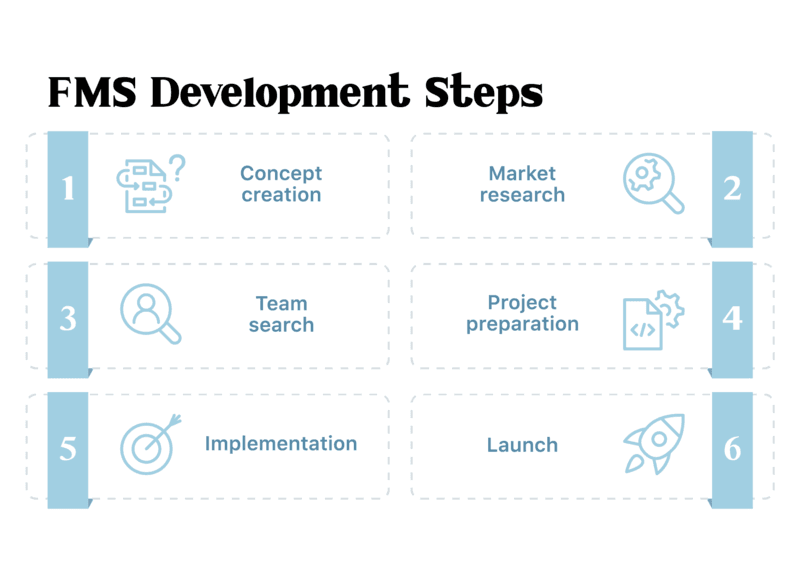
Let's take a look at the basic steps you need to take to make your project dream come true:
-
Concept creation. Start by understanding the needs of your own company. What do you want to get in the end? Decide on the types of fleet software, select the features you might require, find the competitive analogs you like (they’ll serve as an example to be followed or a role model of the sort). All of this will be your primary basis.
-
Market research. The second step is to test your idea. Hire experts to provide you with competent analysis or undertake the work yourself. Your task is to find out the following:
-
What does the modern fleet management software development market demand?
-
Who are your competitors and what are their pros and cons?
-
What is your potential user interested in?
-
-
Team search. While desk research is something you're quite capable of doing on your own, the same cannot be said about web and mobile development. So you have no choice but to find and hire experienced specialists to build fleet management software from scratch or using some ready-made solutions (which isn’t easy too, by the way).
-
Project preparation. Now is the time to discuss your concept with the hired team. You may think your idea is flawless and you've considered everything that really matters, but it never hurts to get the opinion of people with relevant experience. They'll help you improve your strategy and suggest which development approach to take.
-
The Project Preparation stage should end with the signing of an agreement indicating all deadlines.
-
-
Implementation, which includes such steps as:
-
Prototyping designed to create a preliminary model of the future system;
-
Thorough UX/UI elaboration (interface design);
-
The development process itself (the most difficult part of building fleet management solutions);
-
Testing the project. Under no circumstances should you save on the services of QA engineers. By testing a fleet management app, you make sure your resource is working smoothly and without failures.
-
-
Launch. Publishing your digital product is the last step in creating it. And by the by, the work on the project doesn’t stop after the launch. Site or app support is very desirable and sometimes required.
The Cost of Development Of a Fleet Management App
We would be happy to tell you the exact project price, but it's not that simple. Pricing depends on many factors, and the more complex the system, the more expensive the creation process.
When calculating the cost of fleet management software development, we take into account such things as:
-
UI/UX: number of screens, interface type, etc.
-
a set of features for implementation and their complexity;
-
number of platforms and browsers supported;
-
the chosen approach to development (creating from scratch always costs more);
-
subsequent project support.
And keep in mind, the rate of developer services is largely influenced by the reputation of the company, its experience in the market, and even the location! Let's say US and UK developers are asking for more money.
Summing up, we suggest that you prepare a budget of at least 10-15K dollars (or even more).
Best Fleet Management Software
Now we’d like to discuss a few of the existing fleet management platforms. Their example might inspire you.
Fleetio
Let's start our competitor analysis with Fleetio, a cloud-based platform, which helps you efficiently work with your vehicle fleet. The company, which introduced the digital product in question into the fleet management market, has been around for almost a decade (since 2012). Over the years, it has covered 80+ countries around the world with its services, which is clearly a steep success rate.
Fleetio is chosen by businesses of all sizes, small and large ones. Any fleet owner looking to manage it without any hassle should take note of this excellent solution.
What does Fleetio offer?
Fleetio simplifies the fleet management process, whether it's truck tracking, vehicle maintenance, fuel control, or cost optimization. Everything you need to improve your business efficiency is on offer.
Also important is the support provided by Fleetio by e-mail or phone (whichever is more appropriate). And, of course, there are various training webinars and video tutorials aimed to explain to users how to work with Fleetio.
What about the price?
As you already know, the cost of the development of a fleet management app is quite high. But the use of such digital products also requires money to spend.
In the case of Fleetio, the pricing is transparent and clear. The company has two main options, and the most affordable one is called Pro.
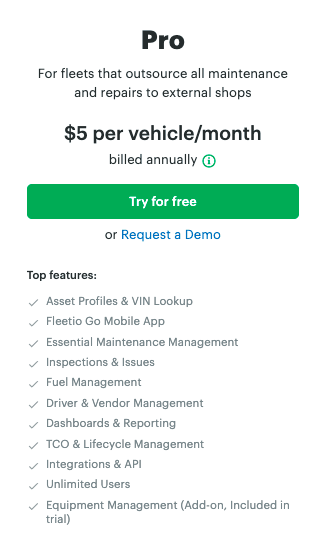
As you can see, even the basic plan provides a lot of cool features, and they are enough for effective fleet management. However, if you want something more, you're welcome to choose the Advanced program.

And one more good news: there is also a two-week trial version, which allows you to test the service and see if it is right for you.
What is the final verdict?
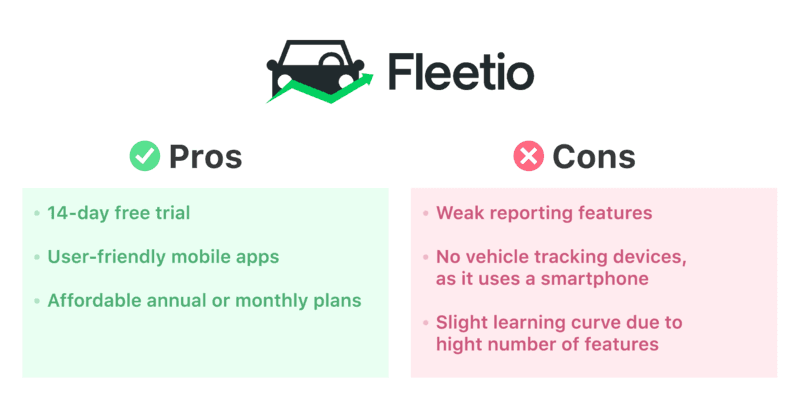
Fleetio has many users, most of whom have left positive reviews. Customers share great experiences with the program and find it a worthy option. However, Fleetio isn't listed on the Better Business Bureau yet.
USFleetTracking
While researching the fleet management software development market, one cannot fail to mention US Fleet Tracking. It has also won a high reputation among users.
Basically, the company makes GPS tracking fleet-targeted devices, and you may wonder why we included it on our list. The fact is, US Fleet Tracking has its own cloud-based system with a number of useful features, including reports on weather conditions, traffic jams, regularly updated data of each device, and more.
Users can customize the work with the platform and choose the mode that suits them. Let's say, they may add a special notification function and receive alerts when conditions set by them are violated (for example, a truck leaves an established zone for no reason).
Pricing
Pricing when interacting with these types of fleet software has a slightly different nature. To be precise, the client pays for the frequency of updating the data of the tracking gadgets. The more frequent the updates, the higher the price.
![]()
What is the final verdict?
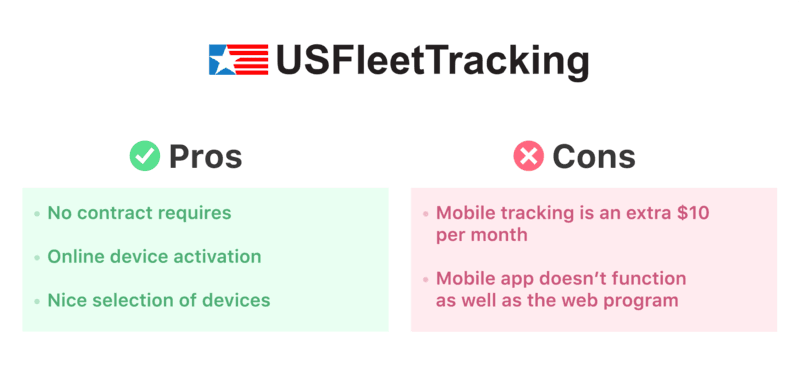
The company is very popular. Its products have been successfully used to improve logistics at such exciting and famous events as the Super Bowl (XLI - LIV), Winter Olympics 2010, 2012 Hoka Hey Motorcycle Challenge, and many others.
HQ Rental Software
The creators of the service in the discussion, having decided to build fleet management software, set their sights on the car rental market, which proved to be a smart move.
To put it simply, HQ Rental Software offers a reliable web and mobile-based fleet platform supplemented with telematic tracking functions and remote car booking features (since we're talking about car rental).
It’s worth noting that telematics is available for a larger fee, which is discussed below. As to online booking, the car rental company can add the corresponding extension to its website so that its customers order vehicles remotely.
In general, HQ Rental Software is very easy to use and allows you to manage your car rental fleet with ease and without unnecessary problems. And clients wishing to book a car are able to get access to all the data they are interested in about each vehicle.
How much does it cost?
Businesses with different budgets can use this fleet management software. The standard package is priced at $ 125 per month, but there are both cheaper and more expensive options.
And the enterprises, especially large ones, might need something special. Therefore, they should make personal arrangements with the HQ Rental Software company to find out the custom fleet management app's exact cost.

What is the final verdict?
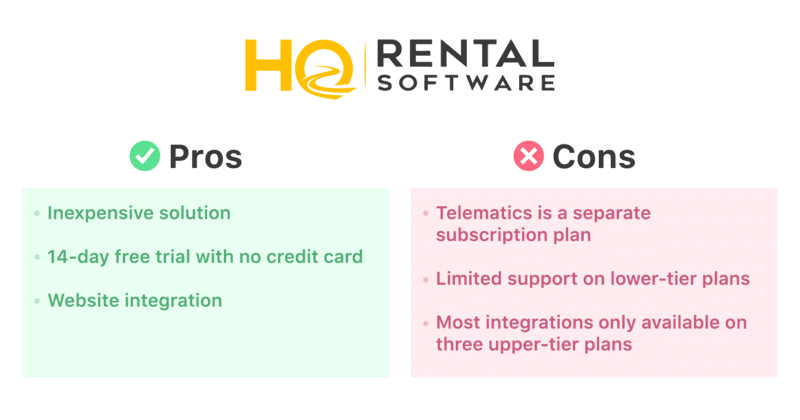
It's time to wrap up our list of the best fleet management platforms. It remains to discuss one more popular product, and that's it.
Onfleet
Onfleet belongs to SaaS fleet management solutions. It means this is a cloud-based solution available from any device, provided the Internet is working well.
Onfleet has existed since 2012 and managed to conquer at least 90 countries with its services.
What does it offer?
Onfleet helps companies deal with various aspects of fleet management in a simplified manner. It offers a clean, clear, intuitive interface, so it doesn't take a lot of time to learn how to use the service. Besides, the onboarding process is facilitated by cool video tutorials.
The application supports iPhone and Android devices and requires no additional equipment to get started (since, as you remember, we're talking about the SaaS fleet management system).
Pricing
You can familiarize yourself with the program with a 14-day trial version. And if it suits you, you’ll have to choose one of 4 packages (see below).
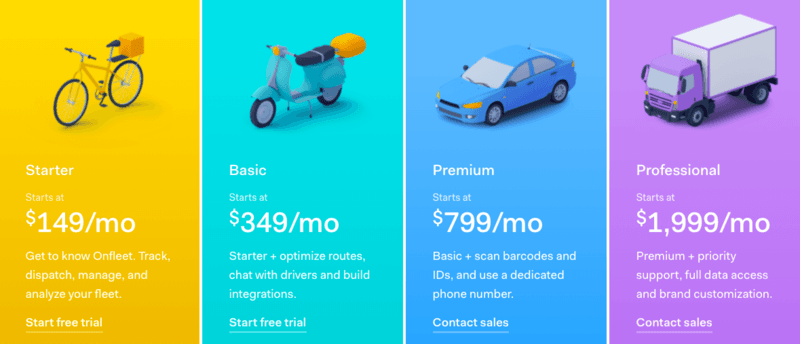
It might seem Onfleet is asking for higher rates compared to previous platforms. And indeed it is. On the other hand, the company took a different approach to pricing. Your costs will depend on the tasks performed by the system (and not on the number of vehicles in service).
What is the final verdict?

The solution is often chosen by businesses with small vehicle fleets interested in maximizing the optimization of the cargo delivery process.
What is Crucial When Building Fleet Management Solutions?
-
Convenient interface. UI/UX creation may not seem like the most important part of the web and mobile development, but it is far from it. The more user-friendly the interface, the easier the system is to use, and the better the final result;
-
Adaptability. Your resource must work equally well on all major platforms and devices;
-
Project evolution. You have to deal with the fact that the system development and upgrowth continues constantly: updates are being released, new features are being added, etc.;
-
Reliable contractor. Don't be stingy when choosing a development company. After all, the quality of your project depends on the qualifications of its employees.


